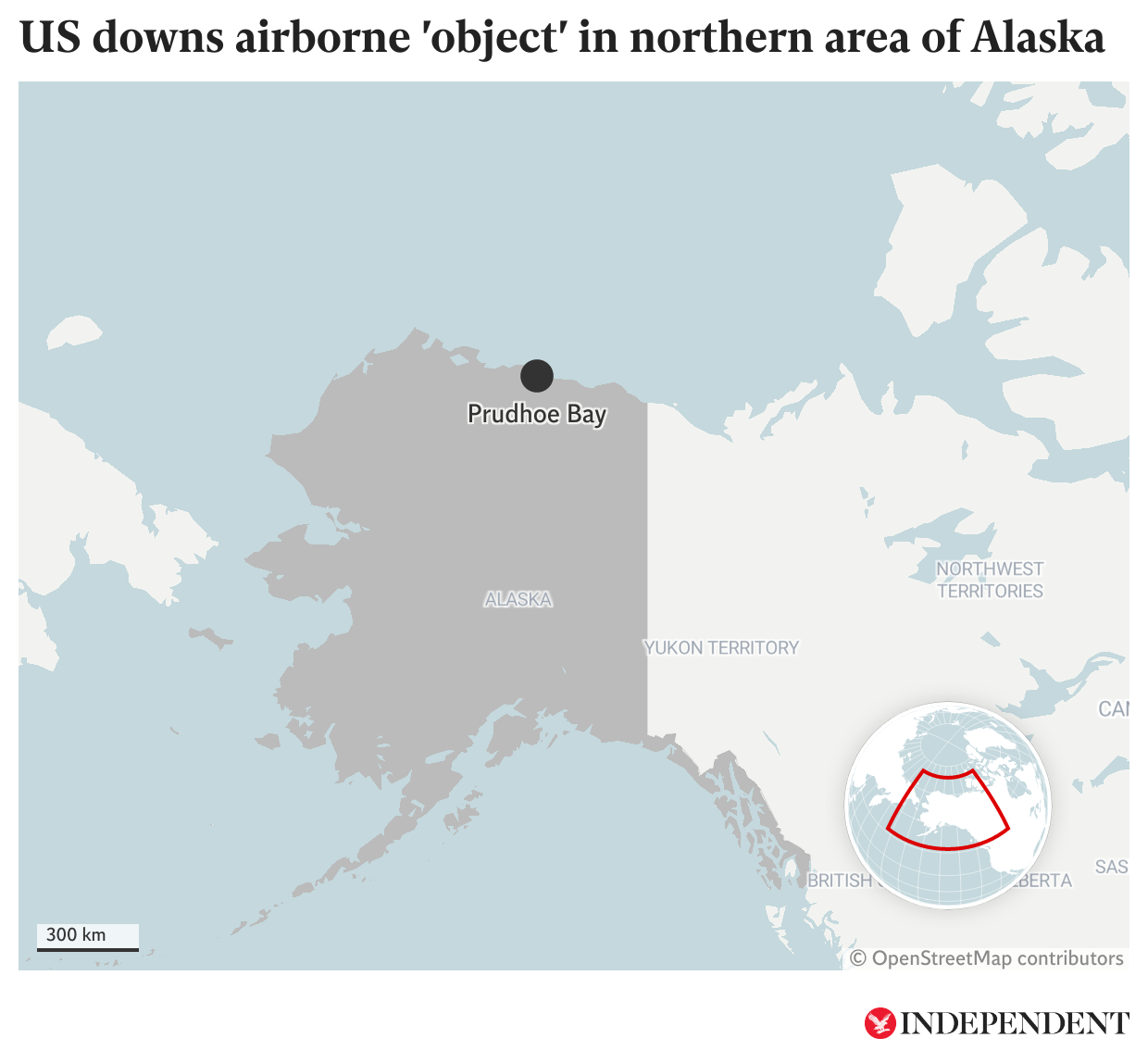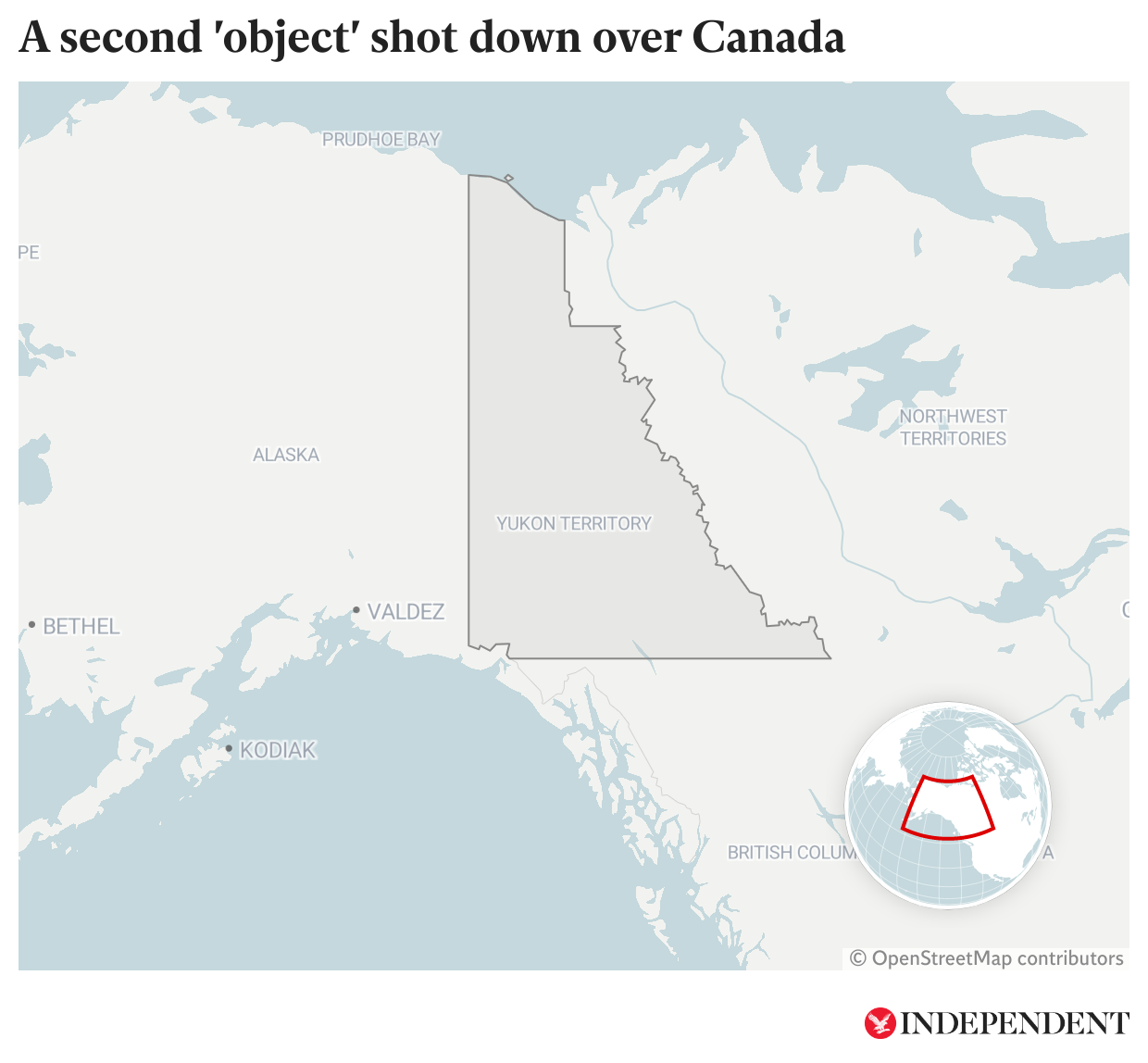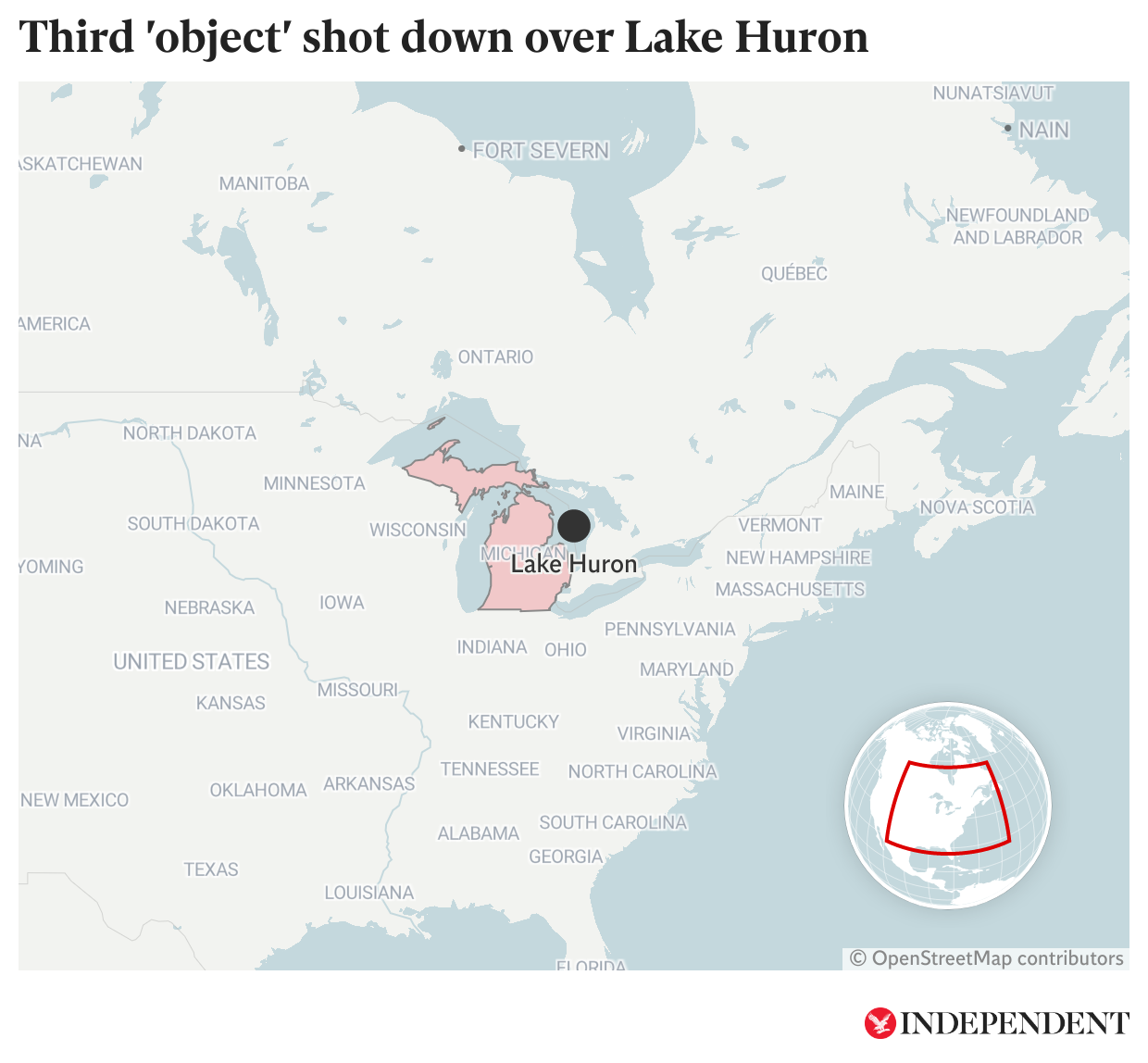
US military fighter jets have been deployed four times within eight days to strike down a large suspected Chinese surveillance balloon and three smaller unidentified flying objects in the skies over Alaska, Lake Huron, and in the Yukon territory of Canada.
Recovery operations are underway in both countries, and military officials have not speculated publicly whether the incidents are connected.
For three days in a row, US military fighter jets brought down similar high-altitude objects, all within a week after a large airship, allegedly sent by China to spy on the US mainland, seized the national news agenda as it drifted across the country before it was destroyed off the coast of South Carolina.
Pentagon officials announced on 11 February that they had brought down a car-sized aerial intruder of “unknown origin” inside US airspace. The following day, an American F-22 fighter shot down a “small” and “cylindrical” object hovering 40,000 feet above Canada. One day later, US officials announced a third “object” was shot out of the sky above Lake Huron near Michigan.
Here’s everything we know so far about the latest mysterious objects.
What exactly happened?
The North American Aerospace Defense Command (NORAD), which monitors and defends the skies over the US and Canada, began tracking an object “about the size of a small car” travelling in a north-easterly direction at an altitude of about 40,000 feet, according to Pentagon press secretary Brigadier General Pat Ryder.
Mr Ryder said on 10 February that it was "not similar in size or shape" to the alleged spy balloon. Other officials said it carried “no significant payload”.

After sending aircraft to get a closer look at the object, the Pentagon recommended to US president Joe Biden that it be shot down. The White House agreed “out of an abundance of caution”.
Two F-22 warplanes were dispatched from Joint Base Elmendorf-Richardson near Anchorage, Alaska, and a single AIM-9 Sidewinder missile was fired around 1.45pm Eastern Time.
Mr Ryder said that all this happened within US airspace and over US territorial waters, with the wreckage landing on frozen sea off Alaska's northern coast.
The warplanes were followed by Pave Hawk and Chinook helicopters, plus a C-130 search and rescue plane, aiming to gather up the remains of the object so that it can be studied.

Officials also were tracking a second object that entered US airspace in Alaska before traveling into Canada, a discovery that was not revealed until 11 February, when another American F-22 Raptor jet shot down the object.
Two F-22 aircraft from Joint Base Elmendorf-Richardson monitored the object over US airspace “with the assistance of Alaska Air National Guard refueling aircraft, tracking it closely and taking time to characterize the nature of the object,” Mr Ryder said in a statement on 11 February.
Canadian CF-18 fighters and CP-140 maritime patrol craft joined the operation.
The object was “small” and “cylindrical” flying at 40,000 feet and “posed a reasonable threat” to civilian aircraft, according to Canada’s Defence Minister Anita Anand.
President Biden “was continually briefed by his national security team since the object was detected,” according to the White House.
Following a call between President Biden and Prime Minister Justin Trudeau, and with the recommendation of their militaries, the president authorised NORAD “to conduct the operation and a US F-22 shot down the object in Canadian territory in close coordination with Canadian authorities,” according to the White House.
It was brought down roughly 100 miles from the US-Canada border in Canadian territory in central Yukon on 11 February.
“To our knowledge, this is the first instance of Norad downing an object in Canadian airspace, and the importance of this moment should not be underestimated,” Ms Anand said during an evening briefing after the encounter.
NORAD and the Federal Aviation Administration briefly closed airspace over northern Montana to support “Department of Defense operations” late on 11 February, responding to a “radar anomaly”.
On 12 February, US officials announced that another object, this time roughly 20,000 feet above Lake Huron near the state of Michigan, was fired out of the sky by an F-16 fighter jet.
Following recomendations from military officials, President Biden ordered that the object be shot down.
At 2.24pm ET, the F-16 fired a Sidewinder missile to strike it down.
Based on its flight path and data, the Pentagon announced that it “can reasonably connect this object to the radar signal picked up over Montana,” according to a statement from the US Department of Defense.

What were the objects, and where did they come from?
The short answer is that we don't know.
Canada’s Defence Minister Anita Anand described the second craft as a “small, cylindrical object”.
Officials have described them as similar in size to a Volkswagen Beetle but “slightly different in profile,” according to The Washington Post.
An “octagonal”-shaped object above Lake Huron was flying at 20,000 feet over Michigan’s Upper Peninsula and traveling towards nearby Lake Huron when it was shot down, according to the US Department of Defense.
"We’re calling this an object because that’s the best description we have right now," White House National Security Council spokesperson John Kirby told reporters on 10 February in a briefing on the Alaskan operation. "We do not know who owns it, whether it’s state-owned or corporate-owned or privately owned."
A subsequent press conference that afternoon offered few answers.

"We have no further details about the object at this time, including any description of its capabilities, purpose or origin," Mr Ryder said. "We will know more once we're able to potentially recover some of those materials."
US military officials have not disclosed whether they believe the objects came from China, whether they have posed any threats to US radar or military sites, or how fast they were travelling.
Mr Ryder did say that there was "no indication" that the object over Alaskan airspce could manoeuvre itself, and he said it was "very, very unlikely" that a craft so small carried human pilots.
Why were the objects shot down?
US and Canadian officials reported that, unlike the large Chinese balloon that floated across the US before it was shot down off the coast of South Carolina, the objects posed "a reasonable threat to civilian air traffic".
The Chinese balloon was flying at about 60,000 feet, well above the range of altitudes for commercial airliners, while the other objects were reported traveling at about 40,000 feet. The object above Lake Huron was at 20,000 feet.
"Any time we detect anything, we're going to first of all observe it, and then decide and take action. In this case, it was operating at an altitude that posed a reasonable threat to civilian air traffic," Mr Ryder said.
Yet many reporters questioned why the Biden administration had demurred in shooting down the Chinese balloon but destroyed the others, speculating that the Pentagon or the president may have been motivated by political pressure.
Mr Biden was heavily criticised by Republican officials for not immediately destroying or disabling the Chinese craft. House Speaker Kevin McCarthy claimed that its appearance was part of “a crisis in America”, while another lawmaker baselessly speculated that it could have contained “bioweapons”.
Officials argued that the risk of civilian casualties in shooting down such a large object over populated land outweighed the likely benefits of shooting it down, saying that it posed no immediate threat to the American public.
The US military was able to protect against the balloon’s ability to collect any intelligence, which was “relatively straight-forward since we knew where the balloon was,” according to Melissa Dalton, the assistant secretary of defense for homeland defense and hemispheric affairs.
US defense officials told a Senate panel that shooting the massive balloon at first sight near Alaska also risked losing salvageable debris – and valuable intelligence – in frozen or deep-water areas where recovery operations would be impossible.
By contrast, the other objects were much smaller. The object shot down over Alaska was flying over the sea when it was shot down, off the coast of the fourth most sparsely populated county (North Slope Borough, Alaska) in the US.
Why are we suddenly seeing them?
Following the Chinese surveillance balloon, the US military has widened its range of radar data as it monitors North American airspace for objects that might have otherwise been filtered out.
The week of incursions has changed how analysts receive and interpret information from radars and sensors, according to a US official who spoke with The Washington Post.
“Sensory equipment absorbs a lot of raw data, and filters are used so humans and machines can make sense of what is collected,” according to the newspaper. “But that process always runs the risk of leaving out something important.”
“We basically opened the filters,” the official told the newspaper, which compared such data filters to those used by a prospective car buyer to broaden the parameters of what can be searched.
But that change does not fully account for the latest incidents, and whether they are deliberate actions by an unknown country or adversary, which analysts also have suggested are testing what a US response would be – and how the nation’s own partisan battles could play out – after that kind of provocation.
CBS News national security correspondent David Martin described the two unidentified objects shot down over Alaska and Canada as “balloon-like” and did not necessarily believe that they were deployed from China.
“The prevailing wind brings everything that way, from east, west, across northern Alaska and northern Canada. And there is a lot of what officials call ‘sky trash’ up there,” he told Face the Nation on 12 February.
That “sky trash” includes “balloons that are put up by governments, that are put up by corporations, put up by research institutes, and probably just by private individuals, and not for nefarious purposes but to just collect scientific data,” he said.
In the past, the US didn’t pay as much attention to such crafts, but the much-larger Chinese surveillance balloon was a “game changer” that put the US military and the Biden administration on alert, he added.
Are there any theories about the objects?
Given the aerial drama surrounding the surveillance balloon, it's natural that the top possibility in many Americans' minds right now would be that the other objects are more surveillance crafts from China, Russia, or elsewhere.
US officials claim that China has long operated an aerial balloon programme that has sent similar craft floating above the US since at least 2017 – whether for surveillance, or to test the US government's response, or both.
There is no shortage of interesting surveillance targets in Alaska, which houses nine US military bases, 18,000 military personnel, sensitive oil infrastructure, various radar and early warning systems directed towards nearby Russia, and missiles designed to shoot down incoming nuclear warheads.
The US National Weather Service also has more weather balloon stations in Alaska than any other state, releasing new ones at the same time every day.
Plenty of scientists and researchers are also interested in the skies over the Arctic, in part because of the region's role in global weather patterns and in climate change.
There is even a sizeable amateur ballooning community that likes to launch cameras, radio equipment, GPS trackers, scientific sensors, and other objects into the stratosphere.







